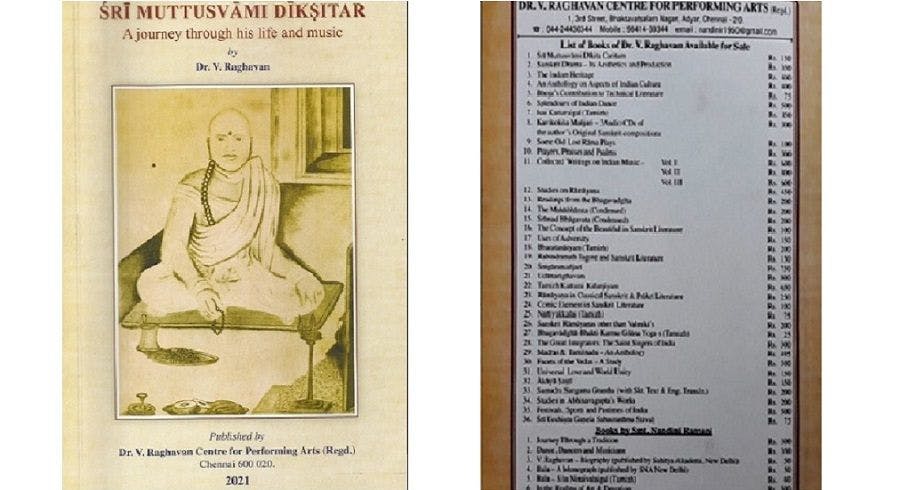Dr V Raghavan’s book, on Muthuswami Dikshitar, youngest of the famed Carnatic trinity, is a comprehensive description of the composer’s musical journey as well as life history.
Dr V Raghavan has been a prolific writer whose erudition in music and Sanskrit is non-pareil. His book titled ‘Sri Muttusvami Diksitar, A journey through his life and music’ carries the reader on a musical pilgrimage with Dikshitar to the numerous places and temples on which the legendary musician made his monumental compositions. And as one progresses into the book, one feels the presence of Dr Raghavan as the guide of this tour. The narration is so exhaustive that the description of the journey is replete with anecdotes that make the reading more captivating. Further, they follow a chronological order as well.
A major part of the first chapter is devoted to introducing Ramaswami Dikshitar, Dikshitar’s father. The author endears him to the readers with the opening sentence that mentions the composition Vatapi Ganapatim “with which most concerts of Carnatic music open”. This is to drive home the point that the raga of the composition Hamsadwani was the creation of Ramaswami Dikshitar. What follows is a biographical sketch of Ramaswami including his musical ingenuity. Among his creations, his magnum opus – Ashtothata sata –raga – tala – malika – a composition in 108 ragas and talas finds mention. After paying visits to many places, he finally settled at Tiruvarur, the location of the famous Thyagaraja Temple. It speaks for his dexterity in both musical and spiritual domains that even today the order and details of music and musical instruments during the varied rituals of the day and even during the festivals and processions in the temple were arranged by Ramaswami Dikshitar.
Western music and nottuswaras
The birth of Muthuswami Dikshitar was a sequel to his parents’ observing austerities before Muthukumara Swami at Govindapuram in Thanjavur district. Hence the relevance of the prefix Muthuswami in his name. They were also blessed with his siblings Chinnaswami, daughter Balamba and Baluswami.
An itinerant musician that Muthuswami was, all the places and temples he visited and the deities in each find a detailed description in the book. The stay at Manali was significant as it brought Muthuswami in contact with the British band.
Baluswami’s exploits in violin took place here. Muthuswami’s 37 nottuswaras also were born here. Also, it was from here that a Yogin Chidambaranatha took Muthuswami for a pilgrimage to Varanasi. The author relates a miracle that finally compelled him to receive the mudra Guru Guha during his short stay at Tiruttani. The family continued its journey visiting Kanchi, Tiruvannamalai and Chidambaram and finally returning to Tiruvarur. Ramaswami’s death occurred there in 1817.
A major portion of Muthuswami’s compositions was born here including the Navaarana and the Navagraha kritis. The inspiration was the Thyagaraja temple and Goddess Kamalamba. As each one is mentioned, the reader gets more and more excited as they are all familiar ones. Interestingly, the list of the neighbouring places, the temples and deities there and the compositions on them is pretty long. The places included Kivalur, Sikkil, Nagapattinam. Mannargudi, Mayuram, Kumbakonam and Tanjavur. It was here that he came into contact with the other two of the Trinity viz. Thyagaraja and Syama Sastri. Another historic meeting was with the Thanjavur brothers who accepted him as their guru. Among them, Ponnayya tried to use the Mela raga names with Kadapayadi prefixes, a list of which, though incomplete, is given. Each of them is connected to a deity as well. Dr Raghavan leaves it to future researchers to complete the list.
Compositions on deities
His journey to Ettayapuram and the historic heavy downpour when he sang the composition Anandamrithakarshani at Sattur, stay at Ettayapuram etc. find a graphic description which the reader is sure to regale himself with. Deities in Kerala temples too fall within this ambit – Ayyappa Swamy, Anantha sayanam and Guruvayurappan.
A song that refers to Kerala has a mention of Rakta-Ganapathi and Dr Raghavan says that he could identify its location as Thiruvananthapuram later. Dr Raghavan himself epitomizes the way he has treated Dikshitar, “The best way to give an account of the kritis by Dikshitar is to deal with them around the kshetras visited by him”.
The author has pointed out that Raga was Dikshitar’s métier, compared to Thyagaraja known for his compositions pregnant with bhava, and the beauty of rhythm prominently experienced in those of Syama Sastri. The 50-page chapter concludes with a summary of the aesthetics of Dikshitar compositions. Raghavan asserts that Dikshitar music was derived from the technique of Vina. A bevvy of compositions is given to corroborate this view.
The next chapters are devoted to the Dikshitar family tree, a list of the Ettayaputram Maharajas – the patrons of the Dikshitar family – a short piece on Chinnaswami and Baluswami, Subbarama Dikshitar and his famous work of Sangita Sampradaya Pradarshini, voluminous description of Dikshitar’s sishya-parampara. While the list of selective discography of Dikshitar kritis runs to several pages, the corpus of Navagraha kritis is given with notations. What follows next is the index of the songs of Dikshitar which is comprehensive and also those of Subbarama Dikshitar.
Three separate chapters on Muthuswami Dikshitar towards the end of the book appears only as a summary of the previous chapters on his life and works, except the third one which throws light on some other facts too. The concluding chapter on Nottuswara Sahithyas is comprehensive and highly didactic.
Published by Dr V Raghavan Centre for Performing Arts (Regd)
First Edition: January 2021
Price Rs. 500/-

